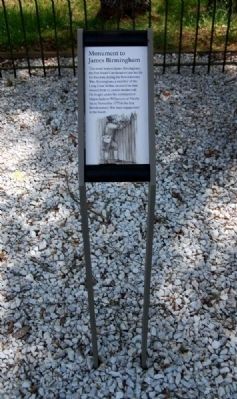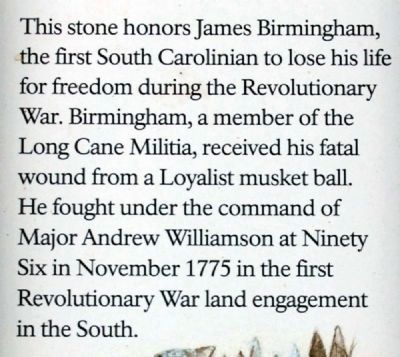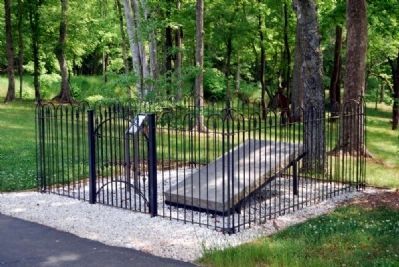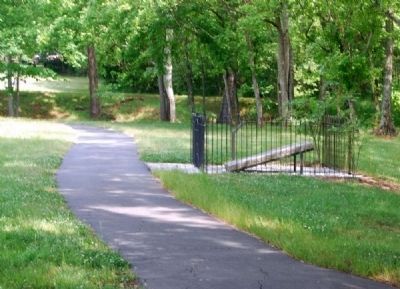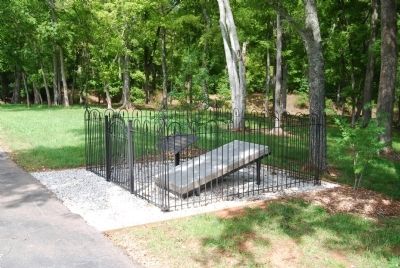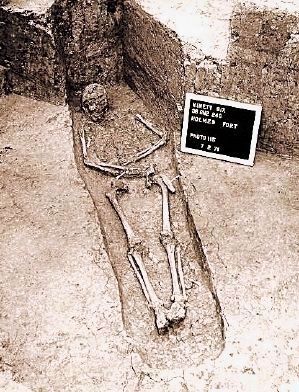Ninety Six in Greenwood County, South Carolina — The American South (South Atlantic)
Monument to James Birmingham
This stone honors James Birmingham, the first South Carolinian to lose his life for freedom during the Revolutionary War. Birmingham, a member of the Long Cane Militia, received his fatal wound from a Loyalist musket ball. He fought under the command of Major Andrew Williamson at Ninety Six in November 1775 in the first Revolutionary War land engagement in the South.
Erected 2009 by National Park Service.
Topics. This historical marker is listed in these topic lists: Colonial Era • Patriots & Patriotism • War, US Revolutionary. A significant historical month for this entry is November 1775.
Location. 34° 8.75′ N, 82° 1.39′ W. Marker is in Ninety Six, South Carolina, in Greenwood County. Marker can be reached from South Cambridge Street (State Highway 248). Touch for map. Marker is in this post office area: Ninety Six SC 29666, United States of America. Touch for directions.
Other nearby markers. At least 10 other markers are within walking distance of this marker. James Birmingham (here, next to this marker); Logan Log House (within shouting distance of this marker); Walking Tour of the Park (about 300 feet away, measured in a direct line); Militiamen (about 300 feet away); a different marker also named Logan Log House (about 300 feet away); Ninety Six in the American Revolution (about 400 feet away); The Siege of Ninety Six (about 400 feet away); Why Is It Called Ninety Six? (about 400 feet away); First Blood Shed for Liberty (about 400 feet away); Ninety Six National Historic Site (about 400 feet away). Touch for a list and map of all markers in Ninety Six.
More about this marker. Marker is located on the grounds of Ninety Six National Historic Site.
Also see . . . Ninety Six National Historic Site. Here settlers struggled against the harsh backcountry to survive, Cherokee Indians hunted and fought to keep their land, two towns and a trading post were formed and abandoned to the elements, and two Revolutionary War battles that claimed over 100 lives took place here. (Submitted on September 9, 2008, by Brian Scott of Anderson, South Carolina.)
Additional commentary.
1. James Birmingham Memorial
Located near the entrance to the stockade fort this granite stone is surrounded by an iron fence. The stone was erected to honor James Birmingham, the first South Carolinian to lose his life in the cause for freedom during the American Revolution. He was a member of the Long Cane Militia and suffered a fatal wound from a Loyalist musket ball. During one of archaeologist Stan South's early excavations in the 1970s, skeletal remains in a shallow grave were uncovered within the outlines of Williamson's Fort of 1775. The remains were photographed and removed to the Department of Archaeology and Anthropology at the University of South Carolina for further examination. are the remains those of Birmingham? The mystery will remain until conclusive evidence proves his identity beyond a doubt. (Source: Old Ninety Six: A History and Guide by Robert M. Dunkerly and Eric Williams (2006), pg 73.)
— Submitted August 27, 2010, by Brian Scott of Anderson, South Carolina.
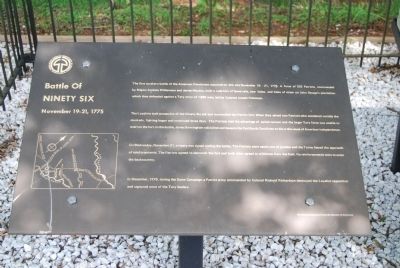
Photographed By Brian Scott, September 5, 2008
4. Original Battle of Ninety Six Marker
The first southern battle of the American Revolution occurred on this site November 19-21, 1775. A force of 532 Patriots, commanded by Majors Andrew Williamson and James Mayson, built a rude fort of fence sails, cow hides, and bales of straw on John Savage's plantation which they defended against a Tory army of 1,890 men, led by Colonel Joseph Robinson.
The Loyalists took possession of Ninety Six jail and surrounded the Patriot fort. When they seized two Patriots who wandered outside the stockade, fighting began and continued three days. The Patriots had the advantage of swivel cannon and the larger Tory force was unable to overrun the fort. In this battle, James Birmingham was killed and became the first South Carolinian to die in the cause of American Independence.
On Wednesday, November 21, a treaty was signed ending the battle. The Patriots were nearly out of power and the Tories feared the approach of reinforcements. The Patriots agreed to demolish the fort and both sides agreed to withdraw from the field. No reinforcements were to enter the backcountry.
In December, 1775, during the Snow Campaign, a Patriot army commanded by Colonel Richard Richardson destroyed the Loyalist opposition and captured most of the Tory leaders.
The Loyalists took possession of Ninety Six jail and surrounded the Patriot fort. When they seized two Patriots who wandered outside the stockade, fighting began and continued three days. The Patriots had the advantage of swivel cannon and the larger Tory force was unable to overrun the fort. In this battle, James Birmingham was killed and became the first South Carolinian to die in the cause of American Independence.
On Wednesday, November 21, a treaty was signed ending the battle. The Patriots were nearly out of power and the Tories feared the approach of reinforcements. The Patriots agreed to demolish the fort and both sides agreed to withdraw from the field. No reinforcements were to enter the backcountry.
In December, 1775, during the Snow Campaign, a Patriot army commanded by Colonel Richard Richardson destroyed the Loyalist opposition and captured most of the Tory leaders.
Credits. This page was last revised on November 19, 2020. It was originally submitted on September 9, 2008, by Brian Scott of Anderson, South Carolina. This page has been viewed 1,208 times since then and 25 times this year. Photos: 1, 2, 3. submitted on August 27, 2010, by Brian Scott of Anderson, South Carolina. 4. submitted on September 9, 2008, by Brian Scott of Anderson, South Carolina. 5. submitted on August 27, 2010, by Brian Scott of Anderson, South Carolina. 6. submitted on September 9, 2008, by Brian Scott of Anderson, South Carolina. 7. submitted on August 27, 2010, by Brian Scott of Anderson, South Carolina. • Craig Swain was the editor who published this page.
